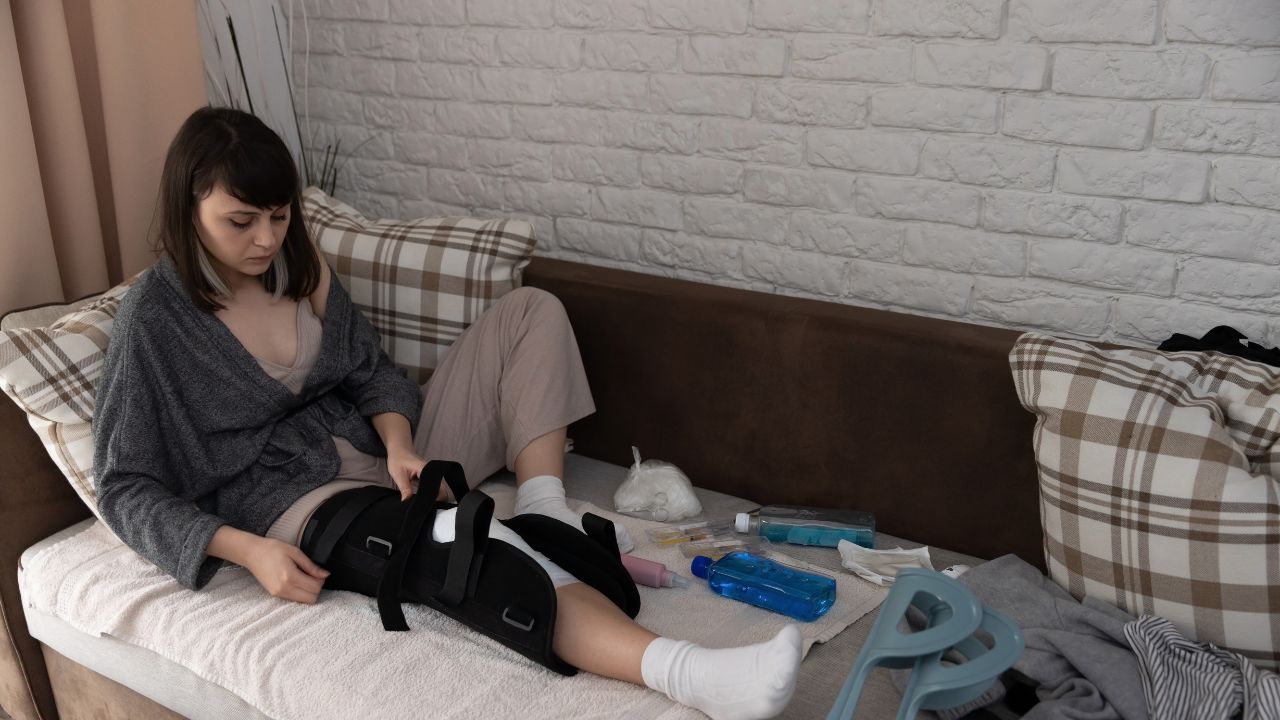This article has been medically reviewed by experts to ensure it provides accurate, reliable, and up-to-date health information. We only use credible sources to support our content.
Recovering from surgery can take time, and many people wonder when it’s safe to return to normal activities like sauna use.
Saunas are known for relaxation, improved circulation, and pain relief, but using them too soon after surgery may affect wound healing, stitches, and overall recovery.
Quick Key Takeaways
- Using a sauna too soon after surgery may increase swelling or delay wound healing.
- Some studies show sauna use with sutures may not harm healing, but medical clearance is always needed.
- Risks include dehydration, bleeding, infection, or reopening of wounds.
- Most surgeons recommend waiting until stitches are removed and wounds are fully healed.
- Always follow your surgeon’s instructions before using a sauna after surgery.
Can I Use a Sauna After Surgery?
You should not use a sauna immediately after surgery. Most doctors recommend waiting until stitches are removed, wounds are fully healed, and your surgeon confirms it’s safe.
While one clinical study found no difference in wound healing when patients used a sauna with sutures after hernia repair (Papp & Alhava, 2003), the risks of swelling, infection, or delayed healing make it important to get medical clearance before resuming sauna sessions.
Why Sauna Use After Surgery Needs Caution
A sauna raises body temperature, improves circulation, and makes you sweat. While these effects can be beneficial in many situations, they may stress the body during recovery. After surgery, tissues are fragile, wounds are healing, and the immune system is working harder than usual.
Heat exposure may increase the risk of swelling, bleeding, or infection if started too early.
What Research Says About Sauna Use After Surgery
Some evidence suggests sauna use does not necessarily interfere with wound healing. For example, a Finnish study on patients with sutures after hernia repair found no difference in wound healing between those who used a sauna a few days after surgery and those who waited until stitches were removed (Papp & Alhava, 2003).
Other studies on postoperative bathing also show that earlier exposure to water does not always increase infection risk (Ren et al., 2024). However, every surgery is different, and sauna heat is more intense than normal bathing.
Overall, while some data supports safety in select cases, surgeons generally recommend waiting until wounds are closed and healing well.
How Long Should You Wait Before Using a Sauna?
There’s no universal answer, but most guidelines suggest waiting until:
- Stitches or staples are removed.
- The wound is fully closed and free from drainage.
- Your doctor confirms it’s safe.
For minor surgeries, this may be a few weeks. For major operations, it could take months. Take a look at the table below to get a more precise answer.
Always follow the advice of your surgeon rather than relying on general timelines.
| Type of Surgery | Estimated Waiting Time | Reasoning | Special Considerations |
|---|---|---|---|
| Minor skin procedures (mole removal, small biopsies) | 1–2 weeks after wound closure | Small incisions heal quickly, but heat/sweat can irritate tissue and dressings. | Confirm full epithelial closure; avoid if any drainage or sutures remain. |
| Hernia repair | 2–4 weeks, or until stitches are removed | Randomized study showed no worse wound healing with early sauna, but swelling is possible. | If mesh implanted, get surgeon clearance; start with brief, mild sessions. |
| Orthopedic surgery (knee, hip, shoulder) | 4–8 weeks minimum | Heat can worsen early postoperative inflammation and edema around joints/soft tissue. | Many ortho protocols avoid sauna/hot soaking until incision fully healed (~4 weeks). |
| Abdominal surgery (appendectomy, C-section, gallbladder removal) | 4–6 weeks or longer | Larger incisions and intra-abdominal healing require longer; heat increases intra-abdominal pressure and moisture at the incision. | Wait for closed, dry wounds; gradually reintroduce heat if cleared. |
| Cardiac surgery (bypass, valve repair) | 8–12 weeks minimum | Sauna causes vasodilation and BP shifts; cardiac patients need longer stabilization. | Cardiologist approval required; avoid with unstable cardiac conditions. |
| Cosmetic surgery (liposuction, facelift, breast procedures, tummy tuck) | 3–6 weeks depending on procedure | Heat and sweating can worsen swelling, threaten steri-strips, and affect scar maturation. | Many plastic-surgery protocols advise avoiding sauna/steam for weeks to months. |
| Dental/oral surgery (wisdom teeth, implants) | 1–2 weeks | Heat may increase oral bleeding and edema; hydration and hemostasis matter early. | Avoid until oozing stops and soft tissues begin to seal. |
| Laparoscopic surgery (minimally invasive) | 2–3 weeks | Smaller incisions heal faster, but internal irritation/inflammation still needs time. | Common guidance allows early showering but avoids soaking/sauna until healed. |
| Major open surgery (organ transplant, bowel resection) | Several months | Extensive internal/external healing and immunologic recovery required; heat stress not advised early. | Specialist clearance essential; consider phased re-entry with mild temps. |
Supporting sources: Papp & Alhava (2003); Copeland-Halperin et al. (2020); Ren et al. (2024); Laukkanen et al. (2018); Michigan Medicine (2021); TCO Orthopedics (2022); Blum et al. (2007).
Potential Risks of Sauna Use Too Soon After Surgery
1. Delayed wound healing due to excess heat and sweating
High heat from a sauna increases circulation and body temperature, which can place stress on fresh surgical wounds. The extra blood flow may cause the area to swell and slow down how quickly tissues close and knit back together. Sweat can also irritate sutures or dressings, keeping the wound moist when it should remain clean and dry. Together, these factors can delay normal healing.
2. Infection if sweat enters unhealed wounds
Open or partially healed wounds are vulnerable to bacteria. When you sweat in a sauna, moisture creates an environment where bacteria thrive, especially around sutures, staples, or drains. If sweat seeps into the wound, the chance of infection rises. Infections after surgery not only prolong healing but may also require antibiotics or further medical intervention.
3. Bleeding or swelling because of increased blood flow
Saunas naturally increase circulation. For someone healing from surgery, this can put pressure on blood vessels near the surgical site. As a result, stitches may strain, minor internal bleeding could occur, and swelling can become worse. In some cases, the extra swelling may even disrupt proper scar formation.
4. Dizziness or dehydration, which can complicate recovery
After surgery, your body is already working hard to recover. Sitting in a hot sauna speeds up heart rate, increases sweating, and can lower blood pressure, which may cause dizziness or fainting. Dehydration is also a concern because the body loses fluids more quickly in the heat.
Both issues can interfere with recovery, especially if you are already on medications that affect blood pressure or hydration levels.
Safer Alternatives During Recovery
If you’re looking for relaxation and healing support during recovery, there are safer options than rushing back into a sauna.
- Gentle walks to improve circulation: Light walking is one of the best activities after surgery, as long as your doctor clears it. It improves blood flow, reduces the risk of blood clots, and helps maintain mobility without straining healing tissues. Even 5–10 minutes a few times a day can make a difference.
- Breathing exercises or meditation for stress relief: Mental stress can slow physical healing. Breathing techniques, guided meditation, or even listening to calming music can promote relaxation and lower stress hormones. These methods provide many of the calming benefits of a sauna without the physical strain of heat.
- Warm (not hot) showers once your doctor approves: A warm shower can relax your muscles, improve circulation, and help you feel refreshed. The key is keeping the water temperature comfortable, not excessively hot. Unlike saunas, showers don’t push your body to sweat heavily or raise your core temperature as much, making them safer in the early stages of healing.
Frequently Asked Questions
- Can I use an infrared sauna after surgery?
Infrared saunas produce heat differently, but the risks remain similar. Wait until your wounds heal and you have medical clearance. - What if I had cosmetic surgery?
Cosmetic procedures (like liposuction or facelifts) often require strict aftercare. Heat and sweating may increase scarring or infection risks, so follow your surgeon’s exact timeline. - Can sauna help recovery in the long term?
Yes, once cleared by your doctor, regular sauna use may support circulation, reduce pain, and help with relaxation during long-term recovery. - What about showering or bathing?
Research shows early showering does not always increase infection risk, but saunas involve higher heat and sweating, which adds extra stress. - When should I ask my doctor?
Ask during your follow-up appointment. Provide details about the type of sauna (dry or infrared) and how often you plan to use it.
References
Blum, N., Simsolo, R., Sirchan, R., & Ben-Ishay, D. (2007). The sauna: A cardiovascular stress. Canadian Family Physician, 53(7), 1052–1055. https://www.ncbi.nlm.nih.gov/pmc/articles/PMC2359619
Copeland-Halperin, L. R., Wall, S., & Warner, J. P. (2020). Does the timing of postoperative showering impact infection rates? A systematic review and meta-analysis. Journal of Plastic, Reconstructive & Aesthetic Surgery, 73(7), 1293–1301. https://doi.org/10.1016/j.bjps.2020.02.007
Hussain, J., & Cohen, M. (2018). Clinical effects of regular dry sauna bathing: A systematic review. Evidence-Based Complementary and Alternative Medicine, 2018, 1857413. https://doi.org/10.1155/2018/1857413
Laukkanen, J. A., Laukkanen, T., & Kunutsor, S. K. (2018). Cardiovascular and other health benefits of sauna bathing: A review of the evidence. Mayo Clinic Proceedings, 93(8), 1111–1121. https://doi.org/10.1016/j.mayocp.2018.05.004
Michigan Medicine. (2021). Facelift postoperative instructions. University of Michigan Health System. https://www.uofmhealth.org/ (example source for patient guidelines)
Papp, A. A., & Alhava, E. M. (2003). Sauna bathing with sutures: A prospective and randomized study. Scandinavian Journal of Surgery, 92(2), 175–177. https://doi.org/10.1177/145749690309200212
Ren, Y., Li, J., Xue, J., Chen, Y., Zhang, H., & Wang, X. (2024). Does earlier bathing increase the risk of surgical site infection? A systematic review and meta-analysis. EFORT Open Reviews, 9(6), eor-23-0062. https://doi.org/10.15365/eor.23-0062
TCO Orthopedics. (2022). Total knee replacement discharge instructions. Twin Cities Orthopedics. https://tcomn.com/
Yip, J., Foo, C. L., & Sim, E. Y. (2020). Does the timing of postoperative showering impact infection rates? A systematic review and meta-analysis. Journal of Plastic, Reconstructive & Aesthetic Surgery, 73(7), 1293–1301. https://doi.org/10.1016/j.bjps.2020.02.007




